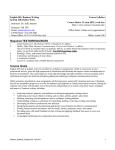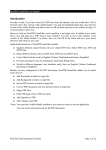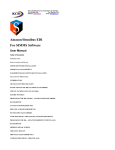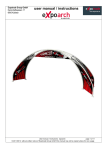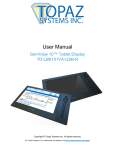Download RoDARS Form User Guide
Transcript
RoDARS Form User Guide City of Toronto Road Disruption Activity Reporting System Contents 1. Background ............................................................................................................................................... 1 2. Applicant Information ............................................................................................................................... 2 3. City Contacts ............................................................................................................................................. 3 4. Brief Explanation of Project ...................................................................................................................... 4 5. Roadway Restrictions ................................................................................................................................ 5 6. Attachments .............................................................................................................................................. 7 7. Communication Protocol .......................................................................................................................... 8 8. Signature ................................................................................................................................................... 9 i RoDARS Form User Guide City of Toronto Road Disruption Activity Reporting System 1. Background The following document provides step-by-step instructions on how to complete the RoDARS notification form. The notification form is comprised of seven sections: Applicant Information, City Contacts, Brief Explanation of Project, Roadway Restrictions, Attachment(s), Communication Protocol and Signature. Although not every field is required to be filled, most of the fields are in place to convey information necessary for the approval process. Failure to disclose certain information or disclosing of information improperly inhibits the approval process. The applicant will be contacted by TMC staff if any information on the form is unclear or missing. For further details, please contact TMC Dispatch at [email protected]. The RoDARS notification form is a fillable online form. In order to avoid any scanning or printing of the form, it is easiest to develop the form on the computer, and provide an electronic signature at the bottom of the page. If a computer system or electronic signature is not available, please write clearly and legibly in the proper fields. A sample form is available on the City's Road Restrictions webpage for reference. 2015-08 1 RoDARS Form User Guide City of Toronto Road Disruption Activity Reporting System 2. Applicant Information This section is intended to provide contact details for both the applicant and project contact. Applicant Name: First and last name of the individual filling out the form. Company Name: The name of the company responsible for the roadway closure. Company Address: The address of the company responsible for the roadway closure. Project Contact: The first and last name of the individual coordinating the project for the applying company. Phone Number (Office): The office phone number of the project contact. The office phone number must be different than the cellular phone number. Please ensure the correct format (e.g. xxx-xxx-xxxx). Phone Number (Cell): The cellular phone number of the project contact. The cellular phone number must be different than the office phone number. Please ensure the correct format (e.g. xxx-xxx-xxxx). Email: The email address of the project contact. Please ensure the correct format (e.g. [email protected]) 2015-08 2 RoDARS Form User Guide City of Toronto Road Disruption Activity Reporting System 3. City Contacts This section is intended to provide the applicant with contact details for the City officials associated with the project. All applications should include at least a City project manager or a City site inspector. For most projects, the City project manager and City site inspector are two different individuals, but for some small projects, the position may overlap. The Work Zone Traffic Coordinators (WZTCs) only coordinate non-expressway roadway occupancy, so their contact information should always be included on all non-expressway forms. In addition to non-expressway closures, the WZTC's contact information should also be included for any expressway occupancies where their dialogue or input has been included any capacity. Project Manager: The City contact who is responsible for overseeing the project. The project manager is often a City engineer. Site Inspector: The City contact who is responsible for ensuring the traffic-related site conditions (i.e. traffic plan) are properly in place and maintained throughout the duration of the roadway occupancy. WZTC: The WZTC who is responsible for coordinating the proposed roadway closure with other road closures to mitigate traffic impacts. Phone Number (Office): The office phone number of the City contact. The office phone number must be different than the cellular phone number. Please ensure the correct format (e.g. xxx-xxx-xxxx). Phone Number (Cell): The cellular phone number of the City contact. The cellular phone number must be different than the office phone number. Please ensure the correct format (e.g. xxx-xxx-xxxx). Email: The email address of the City contact. Please ensure the correct format (e.g. [email protected]) 2015-08 3 RoDARS Form User Guide City of Toronto Road Disruption Activity Reporting System 4. Brief Explanation of Project This section is intended to provide details regarding the nature of the project, whether it is construction work, a planned event or another type of project. The large blank space provided in this section is intended to promote a descriptive explanation of the activities. Check Type of Work Event: Check off the appropriate box to indicate the general type of work or event that is occurring. Permit Number: The permit number must be entered in the correct format (e.g. 66123456) Check if WZTC has Approved this Roadway Closure/Restriction: Check off the available box if the WZTC has approved the roadway occupancy. As WZTC approve the non-expressway closures, the box should always be checked off for non-expressway closures. 2015-08 4 RoDARS Form User Guide City of Toronto Road Disruption Activity Reporting System 5. Roadway Restrictions This section is intended to provide specifics regarding the roadway restrictions. Closed Roadway: The roadway where the closure is occurring. An individual form needs to be submitted for each occupied roadway. Only roadways located on the City of Toronto's right of way can be validated by the RoDARS system. Occupancies occurring partially on the City of Toronto's right of way still require the submittal of a notification form. Roadway under the jurisdiction of the MTO such as the 400 series expressways and their accompanying ramps are not processed through the RoDARS system. From: The beginning boundary of the roadway closure. It is good practice to use the nearest perpendicular cross street as the stated boundary because diverted traffic will often use this location as a detour route. To: The ending boundary of the roadway closure. Again, it is good practice to use the nearest perpendicular cross street as the stated boundary because diverted traffic will often use this location as a detour route. Direction: The direction of the traffic for the occupied traffic lanes. Traffic Lane(s) Occupied (Incl. Shoulders): The lanes occupied by the project activities. The occupied lanes should be specified by direction and lane number. Lane 1 is the lane located adjacent to the roadway's centre line, with lane 2 and subsequent lanes being located right thereof. Shoulders are specified as either the right or left shoulder. If certain lanes are only occupied for specific periods within the occupancy period, please specify such details in this field. Traffic Lane(s) Available: The lanes that are still available to live traffic flow throughout the duration of the project activities. The available lanes should be specified by direction and lane number. Again, lane 1 is the lane located adjacent to the roadways centre line, with lane 2 and subsequent lanes being located right thereof. There is no need to specify the available roadway shoulders. If certain lanes are available for specific periods within the occupancy period, please specify such details in this field. Start Date: The date in which the roadway occupancy is set to commence. Overnight closures should specify a start date of the initial night's date rather than that of the following morning's date. For example, a closure occurring on the night of January 2/morning of January 3 should specify a start time of January 2. End Date: The date in which the roadway occupancy is set to end. Overnight closures should specify an end date of the final morning's date rather than that of the preceding night. For example, a closure occurring on the night of January 2/morning of January 3 should specify an end date of January 3. 2015-08 5 RoDARS Form User Guide City of Toronto Road Disruption Activity Reporting System Daily Checkbox: Indicates that the project is occurring under the same conditions at defined times of the day on a daily basis between the defined start and end times. Continuous Checkbox: Indicates that the project is occurring continuously (24/7) from the start time until the end time. Start Time: The time in which the roadway occupancy is set to commence. If the closure is specified as daily, the roadway will remain open on a daily basis until the start time occurs. If the closure is specified as continuous, the roadway will close and not reopen until the defined end time on the end date. It is best practice not to use a start time of 12:00 AM/PM, 00:00, 12:00 or 24:00 as it may confuse those attempting to interpret the closure's information. Instead, use 00:01, 11:59, 12:01 or 23:59 when a closure starts at one of the aforementioned unclear times. Both the 12-hour and 24-hour clock timing standards are acceptable. However, please ensure that only one standard is used throughout the entire form. Also ensure that the 12-hour standard clearly states whether the time is set to occur in the AM or PM period. End Time: The time in which the roadway occupancy is set to end. If the closure is specified as daily, the roadway will reopen on a daily basis when the end time occurs. If the closure is specified as continuous, the roadway will close and not reopen until the defined end time on the end date. It is best practice not to use an end time of 12:00 AM/PM, 00:00, 12:00 or 24:00 as it may confuse those attempting to interpret the closure's information. Instead, use 00:01, 11:59, 12:01 or 23:59 when a closure starts at one of the aforementioned unclear times. Both the 12-hour and 24-hour clock timing standards are acceptable. However, please ensure that only one standard is used throughout the entire form. Also ensure that the 12-hour standard clearly states whether the time is set to occur in the AM or PM period. Additional Notes: Documentation of any roadway occupancy anomalies that may need to be noted. Compliance to specific traffic standards such as the OTM, Book 7, turn restrictions or pay duty officers can also be documented in this section. This section is also a good location to add any quick sketches to the form that may better help explain the roadway occupancy configuration. 2015-08 6 RoDARS Form User Guide City of Toronto Road Disruption Activity Reporting System 6. Attachments Select the checkboxes that apply to any attachments that may be submitted with the notification form. 2015-08 7 RoDARS Form User Guide City of Toronto Road Disruption Activity Reporting System 7. Communication Protocol The applicant must notify the City of Toronto if either of the following situations arise: • • The work schedule and/or work zone plan has been revised or postponed. The applicant must submit a revised and approved RoDARS notification form at least one business day before changes are set to occur. The work has been cancelled or completed early. The applicant must contact TMC Dispatch. 2015-08 8 RoDARS Form User Guide City of Toronto Road Disruption Activity Reporting System 8. Signature The purpose of this section is to declare that the document details are valid. Applicant Name (Print): First and last name of the individual filling out the form. Applicant Signature: Signature of the individual filling out the form. In order to avoid any unnecessary scanning or printing of the RoDARS notification form, it is best to sign the form with an electronic signature. Date (yyyy-mm-dd): The date on which the form is completed. If changes are made to the form, ensure that the latest date reflects when such changes occurred. In order to avoid misinterpretations of the date, please follow the yyyy-mm-dd date format. 2015-08 9











